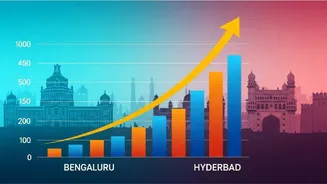Sales Dip Unveiled
During the third quarter of 2025, housing sales in India's leading eight cities experienced a slight downturn. The total number of units sold reached 95,547,
marking a 1% decrease when contrasted with the previous period. This reduction is a key aspect, indicating a minor cooling in demand despite the backdrop of economic fluctuations and seasonal influences. Analyzing the reasons behind this minor dip, market observers point to various factors, including adjustments in interest rates, changes in buyer sentiment, and broader economic conditions, which influenced the decisions of both investors and end-users. This insight provides a valuable perspective on the nuanced state of the market, offering a detailed understanding of the patterns and the subtleties present within the real estate landscape.
Value Jumps Explained
Despite a slight decrease in sales volume, property values across the same top cities experienced a substantial increase. The overall value of residential properties surged by 14% during the third quarter of 2025. This rise suggests a robust underlying demand, with prices reflecting factors like increasing construction expenses, the appeal of prime locations, and a general upswing in the market. The dynamics within different areas of these cities reveal further insights. High-end properties, particularly, contributed to the value increase, while affordable housing segments showed more moderate growth. This expansion in value also draws attention to the effect of infrastructure advancements, which often drive up property prices, and the role of real estate as a store of value amid economic uncertainties. This makes it crucial to study price changes in diverse localities.
Festive Season's Influence
The third quarter of the fiscal year generally coincides with the festive season in India, which exerts a notable impact on the real estate market. During this time, the sentiment around real estate improves, influencing prospective buyers. This year, the festive season's effect, though present, was not as strong as expected due to existing market conditions and economic concerns. Promotions, discounts, and attractive financing options typically offered by developers played a vital role in stimulating demand. In addition, the release of new projects and units in several cities bolstered customer interest. However, the degree to which these efforts translated into actual sales varied. The interplay between promotional strategies and buyer purchasing patterns provides critical information on the behavior of the real estate market during peak seasons.
Economic Factors Impact
Broader economic factors significantly influence the fluctuations within the housing market. In the third quarter of 2025, inflation rates, interest rate adjustments, and GDP growth played a major role in shaping market dynamics. Rising inflation may diminish purchasing power, affecting property demand, while interest rate modifications can change home loan affordability. A healthy GDP growth often boosts confidence in property investments. Economic policy decisions by the government, such as modifications to stamp duties, subsidies, or tax incentives, further affect market activity. These different economic components collectively create a complex environment. Comprehending these interdependencies is essential for real estate investors, market analysts, and individuals looking to invest in property, as they navigate the constantly changing economic climate.
Looking Ahead
Looking ahead, the direction of the housing market in these top cities will depend on numerous variables. Experts predict that interest rate policies, upcoming infrastructural projects, and shifts in buyer confidence will have a strong effect. A stable economic environment and consistent job growth are crucial for sustaining long-term market expansion. Market analysts are carefully observing demographic trends, urban expansion patterns, and adjustments in government housing policies to predict the trajectory of the market. Staying updated with these factors and their interplay is crucial for those in the real estate industry, allowing them to make informed decisions and stay ahead of changes in the industry.














